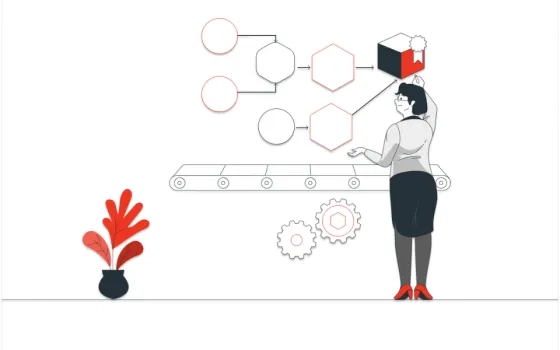Overview
Most businesses have held data in an organizational bubble for generations. Data Analytics teams have traditionally supported core businesses, and as data grew increasingly important in decision-making and product success, data pipeline teams were considered more like workers than partners.
However, in 2023, data will no longer have a secondary status. With improved automation, more diversified positions, and a greater grasp of data’s full potential, many organizations have grown to regard the entire data product ecosystem as a fully developed component of the company’s product suite.
The top innovative teams are wholeheartedly embracing the new reality: handling data as a product. Before you get confused with all the terminologies, a “data product” is not synonymous with “data as a product.” A data product uses data to help achieve the product’s aim, whereas data as a product views data as the actual product. “Data as a Product” approach is crucial in democratizing data.
Let’s talk about the notion of data product and data-as-a-product and what it takes to make this innovative approach a reality.
What Exactly is a Data Product?
A data product is a product in which data is the primary facilitator of its main objective. This implies that a data product is any technological product or element that depends on data to reach its ultimate goal or purpose.
A data product, in essence, is any platform or tool that analyzes data and provides results. The key motivator for enterprise adoption is accomplishing corporate goals through empowered decisions made with insights from data products.
The competitive benefits offered by upgrading products or services based on consumer data, website engagement, surveys, and other data assets via data-driven research provide considerable economic value.
Data products are frequently associated with corporate entities, such as clients, suppliers, equipment, site, or warehouses. Because a corporate entity’s data is commonly dispersed across several source systems, a data product requires data integration, harmonization, and constant synchronization with the fundamental source systems.
The data product consists of its definition (metadata) and the resultant dataset, as explained below:
Data Product Definition AKA Metadata
Data Product Definition (metadata) is information about a data product that is not particularly physical in nature but rather cognitive. Metadata, sometimes known as “data about data,” is a fundamental component used to convert a data product into an enterprise-wide value.
Metadata is essential for supporting data governance initiatives, regulatory compliance standards, and data management procedures since it helps comprehend the data behind the data product and represents how it is handled.
Data Product Definition includes the following:
1. Static Metadata: It includes all necessary databases and tables that collect data from the data product.
2. Active Metadata: Deals with data product consumption and performance.
3. Synchronization Rules: These specify when and how data is synchronized with data repositories.
4. Algorithms: Used for transforming, processing, enriching, and masking raw data.
5. Data Connectors: Load input data into the data product and provide the dataset to data users.
6. Data Governance Rules: Ensure that data integrity and security are enforced in accordance with internal and external requirements.
7. Access Controls: Control credential assessment and authentication.
Data Product Dataset
A data product dataset is a compilation of connected, discrete elements of data about the data product that may be viewed separately, in conjunction, or as a whole entity.
A data set is arranged into a data structure of the product.
Data Product Dataset Characteristics:
– It is managed as a unit, making it simple to handle and access.
– Unified, cleared, concealed, and enhanced.
– Persisting, virtualizing, or caching.
– An audit log keeps track of data modifications in the dataset.
The definition and data of a data product are handled independently, with a data product containing a single definition and several versions of its data.
Types Of Data Products
Although data products are classified in various ways, they are most typically defined by how companies handle type of data and the sort of function they provide.
1. Raw Or Unprocessed Data
This is the most fundamental type of data acquired by the system. If the data is raw, it signifies that it has not yet been processed or used. However, companies can still process this data as a data product to increase its worth.
2. Derived Information
This is a more personalized form of raw data in which additional procedures are done to make the raw data more understandable, such as computing the average or total of a specific property.
3. Algorithms
Only an algorithm can give an outcome by reading and processing data. Some of these techniques may need the execution of a machine-learning model on the provided data.
This category includes the following two data products: insights/decision support and automated decision-making.
– Decision Support (Insights): Although decision support algorithms can handle much of the processing, the processed response is delivered to the user as a data product so that inferences may be drawn from the processed data. That is, something requires more human interaction to function.
– Automated Decision-Making: This may be viewed as a one-size-fits-all algorithm. These data products will provide an outcome without requiring foreign support from the company’s users.
Data Product Examples
Salesforce’s Einstein AI, which delivers customer predictive analytics, and finance terminals such as the Bloomberg Terminal are typical data products. However, meaningful data applications do not have to be enterprise-level to influence a business. As a result, companies frequently create internal data products to ensure data protection, integrity, and flexibility.
More Examples Of Data Products
– Any online shopping site could be a data product if the displayed items change based on my prior purchases and searches.
– Google Analytics is a data product since the insights it provides to users are based on data.
– A data warehouse is a data product that combines raw data, derived data, and insights.
– A self-driving automobile is an example of automated decision-making.
The simplicity of using a data product that can be widely embraced as an enhanced economic solution, like other technological developments, is vital. Data products, like beta testing, should be improved through recommended ways by consumers who use the data product daily.
Understanding Data As A Product
Consider data in different ways for a time. Rather than complicated stats and figures, see each data set as an item or product on a local supermarket shelf. As a customer, there are a few things you’d want to know when you go into a local supermarket.
First, you’d expect that the products are well-organized and easily accessible. For example, when shopping for apples, you wish to find them on the appropriate racks. That’s just a regular aspect of your supermarket shopping experience. The same holds true for your data.
What Is Data As A Product?
Data as a product is all about looking at the data you gather and analyzing how it will affect individuals downstream – your data citizens, end users, and others. Viewing data as a product is similar to viewing your shopping components as products.
You must look after your data, organize it, and make it simple for data citizens and end users to locate, trust, and use. And it is up to you, as an organization, how you organize that data and treat it as a product.
Best Practices for Treating Data As A Product
The Data Delivery Lifecycle
Data teams should take a cross-operational product lifecycle approach to embrace a “Data as a Product” strategy. The data product delivery lifecycle should adhere to a lean manifesto by being short and continuous to provide immediate, additional value to data users.
Establish The Data Product Plan
Define the data requirements in the context of the business objectives, data privacy and governance limitations, and the inventory of current data assets. Then, the design for data formatting and componetization comes into picture.
Construct The Data Product
Create the data product based on the needs by finding, integrating, and gathering data from its sources, then concealing it as needed. Next, develop web applications APIs that allow consuming programmes with the appropriate credentials to access the data product and design pipelines to safely distribute the data to subscribers.
Validation Of The Data Product
Focus on testing the data to ensure it is comprehensive, accurate, and reliable and can be securely accessed by large-scale applications.
Maintenance And Repair Of The Data
Monitor statistical measurements, pipeline efficiency, and stability, and collaborate with data engineering to solve problems.
How Can The Use Of Data As A Product Increase Quality Data And Usability?
Moving away from a single warehouse and transferring responsibility from centralized teams to a decentralized network of domains are the goals of the “data as a product” approach. Here are some reasons why data products may increase data accuracy and usability.
Data Accuracy: By maintaining the data with the domain responsible for it, you ensure that all information acquired is contextually aware. When cleaning and preparing data for consumption, data professionals have a much smaller pool of data to deal with and a better grasp of it. The most critical aspect of data accuracy is that the domain genuinely cares about its data. This is why enabling your domains through the “data as a product” strategy will considerably increase data accuracy.
Data Usability: Treating data as a product prioritizes data usability and search. Domains are in charge of preparing data for consumption. As previously said, data as a product must provide self-service functionalities to allow the owner domain and other business domains to use the data for their own needs.
Advantages Of Data As A Product
Data productization can enhance your entire business, particular departments, data citizens inside your organization, and, of course, your end consumers. Below are a few concrete ways how data-as-a-product methods might improve your organization’s data strategy.
1. Data Citizens Empowerment
It’s no wonder that data citizens, particularly those new to it, can fear large amounts of data. Productizing data can help to reduce the complexity of data implementation by breaking down large data sets into smaller bits that are easier to regulate and comprehend.
2. Control And Regulate Data At The Same Time
Data-as-a-product enables your company to build a controllable framework around your data while providing something meaningful to your data users that enables their data literacy. As a result, you’ll make it easier for your data users to access, trust, and use data than ever before, resulting in more victories.
3. Enhances Data Quality
If you’re trying to make a delicious meal with tomatoes, it stands to reason that the freshness and quality of those tomatoes will directly influence the recipe as a whole. This means that the completed result strongly relies on the components’ quality. When you handle data as if it were a product, you organize it, establish governance, increase its quality and usefulness, and improve and affect any data project. As a result, the quality of that data will influence everything that happens downstream of it.
4. Improves Context And Simplifies Accessibility
Lack of context can cause confusion in data matters. For example, suppose your marketing department seeks marketing data sets from your analytics team without providing context for your project. In that case, you’re likely to receive a slew of data sets that don’t correlate, don’t sound right to you, and don’t deliver the insight you want. When data is regarded as a product, the appropriate context is ascribed to it. This makes data easier to comprehend, access, and use.
How Can Organizations Use The Data-As-A-Product Strategy?
1. Obtain Stakeholder Consensus Early On
When you sell data, your internal users are also your stakeholders. So, like you plan out your data product portfolio, set SLAs, and start treating data as a product, make it a point to collaborate with your primary data consumers.
2. Adopt A Product Management Mentality
Another critical step is approaching data product development, monitoring, and measurement with a product management perspective.
So, when it comes to pipelines and processes, utilize the same tried-and-true practices that you would with production software, such as producing scope papers and dividing projects into iterations.
3. Engage In Self-Service Technology
To move data out of barriers and consider it a valuable commodity in its own right; business users must be able to self-serve and fulfill their data demands. In addition, self-service data access for non-technical teams enables your data staff to focus on creative projects that offer value.
4. Emphasize Data Quality And Dependability
A critical aspect of addressing data as a product is applying rigor requirements across the whole ecosystem, from data acquisition through consumer-facing data outputs. This implies emphasizing data quality and dependability throughout the data lifecycle, as we described before in the narrative context.
Pick The Best Team Structure For Your Data Processing
Team structure, of course, has a significant influence on how your business interacts with data daily. For example, do you have a centralized data team in charge of all data administration and applications? Or are analysts integrated throughout business divisions, fulfilling unique requirements and building subject competence despite silos and a lack of unified governance?
Again, each company has its unique cultural environment and difficulties to overcome. Still, an adaptable architecture may assist growing teams in meeting business objectives quickly while maintaining control of data integrity and management.
Conclusion
Studying these notions reveals that they all rely heavily on precisely collected data. “Data product,” on the other hand, is a broad concept, whereas “data as a product” is a subset of all conceivable “data products.” To put it another way, “data as a product” is derived from the “data product.”
Moreover, now you have a better knowledge of what data as a product and data products are; and can utilise the knowledge to create, purchase, or deal with such concepts in the coming years.




















